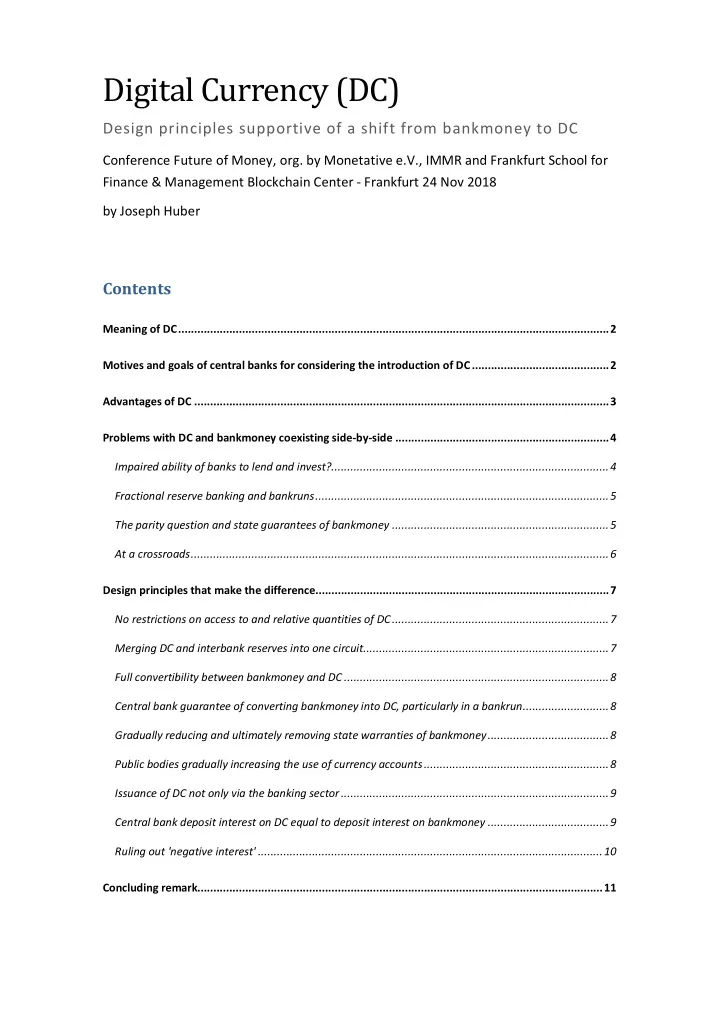

Digital Currency (DC) Design principles supportive of a shift from bankmoney to DC Conference Future of Money, org. by Monetative e.V., IMMR and Frankfurt School for Finance & Management Blockchain Center - Frankfurt 24 Nov 2018 by Joseph Huber Contents Meaning of DC ....................................................................................................................................... 2 Motives and goals of central banks for considering the introduction of DC ........................................... 2 Advantages of DC .................................................................................................................................. 3 Problems with DC and bankmoney coexisting side-by-side ................................................................... 4 Impaired ability of banks to lend and invest?....................................................................................... 4 Fractional reserve banking and bankruns ............................................................................................ 5 The parity question and state guarantees of bankmoney .................................................................... 5 At a crossroads ................................................................................................................................... 6 ............................................................................................ 7 Design principles that make the difference No restrictions on access to and relative quantities of DC .................................................................... 7 ............................................................................. 7 Merging DC and interbank reserves into one circuit Full convertibility between bankmoney and DC ................................................................................... 8 ........................... 8 Central bank guarantee of converting bankmoney into DC, particularly in a bankrun Gradually reducing and ultimately removing state warranties of bankmoney ...................................... 8 Public bodies gradually increasing the use of currency accounts .......................................................... 8 Issuance of DC not only via the banking sector .................................................................................... 9 Central bank deposit interest on DC equal to deposit interest on bankmoney ...................................... 9 Ruling out 'negative interest' ............................................................................................................ 10 Concluding remark............................................................................................................................... 11
2 Meaning of DC Digital currency (DC) is a now widely discussed concept of a new form of central bank money. It is meant to circulate side-by-side with bankmoney (i.e. sight or demand deposits), in parallel and competition with it, similar to the still familiar co-existence of central-bank cash with bankmoney. First design studies on DC were put forward by the Bank of England, the Swedish Riksbank and the BIS, but also from academic researchers and earlier on from monetary reform initiatives. 1 Meanwhile, most central banks have expressed their interest in such an approach. Initially, DC was imagined to come in the form of cryptocurrency based on DL or blockchain technology. The new technology, however, is still in its infancy. 2 By comparison, tried and tested ways of how to manage money-on-account and payments from and to accounts are fully suited for implementing DC. For the foreseeable future, DC is very likely to come in the form of money-on-account – which does not exclude the application of cryptographic technology in a more distant future. Firms and people would chose to maintain a bankmoney account (a bank giro account), or a currency account, or both in parallel. Motives and goals of central banks for considering the introduction of DC What are the motives behind central bank issued DC? The reason given in Sweden is providing a modern successor token to traditional cash. Cash has fallen there almost into disuse. An unspoken worry related to this is that a central bank with no more central bank money in public circulation might look somewhat redundant, sort of King Lackland. In partial response to that worry, another working paper by the Bank of England, written by Dyson and Meaning, emphasizes the potential of DC for making conventional instruments of monetary policy more effective again. Today, the supposed transmission of base rate policy onto banks, finance and the real economy 1 Barrdear/Kumhof 2016 3–18, Kumhof/Noone 2018 4–22, 35–37, Sveriges Riksbank 2017, Dyson/ Meaning 2018, BIS 2015, 2018, Bech/Garratt (BIS) 2017, Niepelt (SNB) 2015. Other academic and institutional supporters of digital currency include Bordo/Levin 2017, Bordo 2018, Eichengreen 2017. Pioneering inputs on the part of the IMMR were made by Dyson/Hodgson 2016, Wortmann 2016, Yamaguchi/Yamaguchi 2016, Huber 2017 188–190, 2018 [first ed. 2014]. 2 Among related problems is the high volatility of cryptocoins, due to their being used as speculative casino tokens rather than a means of payment. Transferring cryptocoins is not fast enough for now, is much too energy-intensive and is thus comparatively expensive. Crypto trading platforms are vulnerable to hacker attacks. There is no guarantee of safeguarding, and legal questions of liability and identifiability are unsettled.
3 has become rather weak. With a growing share of DC in the stock of money, the quantity lever of interest rate policy would increase correspondingly. Rise of the bankmoney regime, marginalisation of central-bank money 100% 90% Central-bank money (cash) 80% 70% 60% 50% Bankmoney (sight deposits) 40% 30% 20% M1 Germany 1948 – 2016 11% cash vs 89% bankmoney 10% 0% 1948 1950 1955 1960 1965 1970 1975 1980 1985 1990 1995 2000 2005 2010 2013 2016 Sichtdepositen Bargeld Da ten : De utsche Bu ndesban k, Mo natsbe richte , Tabellen zur ba nksta tistische n Gesa m tre chnu ng, 1954-201 7. The reasoning is that down to the present day bankmoney has marginalized central bank money in M1, presently to a proportion of about 80–95% bankmoney to 20–5% cash (not to speak of MMF shares that represent an amount of 2,5 times M1 in the US and 1/3 in Europe, still). That proportion indicates the dwindling influence of central bank money and monetary policy on the creation of bankmoney. If, however, that shift could be reverted, so that there would again be more central bank money in proportion to bankmoney, then the transmission lever of conventional interest-rate and quantity policies could correspondingly be expected to be more effective again. Advantages of DC So, an important advantage of DC is a possibly expanding base of central bank or sovereign money, which improves the effectiveness of conventional instruments of monetary policy. That would restore a good deal more central-bank control over money creation and the existing stock of money. Furthermore, DC is absolutely safe, in contrast to bankmoney that is inherently unsafe and must be backed by a number of auxiliary constructions which themselves are of dubious reliability (such as e.g. equity ratios, deposit insurance, government bail for bankmoney). In making DC payments directly from the payer's to the payee's account, the counterparty risk (aka default risk) in this regard is eliminated. DC would thus be trusted and accepted.
Recommend
More recommend